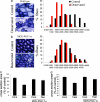PGC-1alpha protects skeletal muscle from atrophy by suppressing FoxO3 action and atrophy-specific gene transcription
- PMID: 17053067
- PMCID: PMC1637570
- DOI: 10.1073/pnas.0607795103
PGC-1alpha protects skeletal muscle from atrophy by suppressing FoxO3 action and atrophy-specific gene transcription
Abstract
Maintaining muscle size and fiber composition requires contractile activity. Increased activity stimulates expression of the transcriptional coactivator PGC-1alpha (peroxisome proliferator-activated receptor gamma coactivator 1alpha), which promotes fiber-type switching from glycolytic toward more oxidative fibers. In response to disuse or denervation, but also in fasting and many systemic diseases, muscles undergo marked atrophy through a common set of transcriptional changes. FoxO family transcription factors play a critical role in this loss of cell protein, and when activated, FoxO3 causes expression of the atrophy-related ubiquitin ligases atrogin-1 and MuRF-1 and profound loss of muscle mass. To understand how exercise might retard muscle atrophy, we investigated the possible interplay between PGC-1alpha and the FoxO family in regulation of muscle size. Rodent muscles showed a large decrease in PGC-1alpha mRNA during atrophy induced by denervation as well as by cancer cachexia, diabetes, and renal failure. Furthermore, in transgenic mice overexpressing PGC-1alpha, denervation and fasting caused a much smaller decrease in muscle fiber diameter and a smaller induction of atrogin-1 and MuRF-1 than in control mice. Increased expression of PGC-1alpha also increased mRNA for several genes involved in energy metabolism whose expression decreases during atrophy. Transfection of PGC-1alpha into adult fibers reduced the capacity of FoxO3 to cause fiber atrophy and to bind to and transcribe from the atrogin-1 promoter. Thus, the high levels of PGC-1alpha in dark and exercising muscles can explain their resistance to atrophy, and the rapid fall in PGC-1alpha during atrophy should enhance the FoxO-dependent loss of muscle mass.
Conflict of interest statement
The authors declare no conflict of interest.
Figures





References
-
- Bassel-Duby R, Olson EN. Annu Rev Biochem. 2006;75:19–37. - PubMed
-
- Glass DJ. Nat Cell Biol. 2003;5:87–90. - PubMed
-
- Jackman RW, Kandarian SC. Am J Physiol. 2004;287:C834–C843. - PubMed
-
- Lecker SH, Solomon V, Mitch WE, Goldberg AL. J Nutr. 1999;129:227S–237S. - PubMed
-
- Lecker SH, Goldberg AL, Mitch WE. J Am Soc Nephrol. 2006;17:1807–1819. - PubMed
Publication types
MeSH terms
Substances
Grants and funding
LinkOut - more resources
Full Text Sources
Other Literature Sources
Molecular Biology Databases
Research Materials

